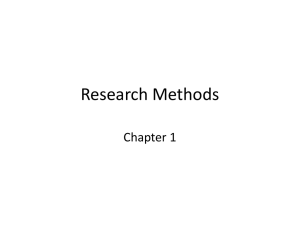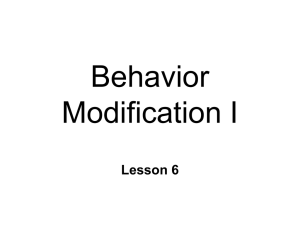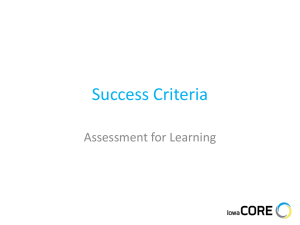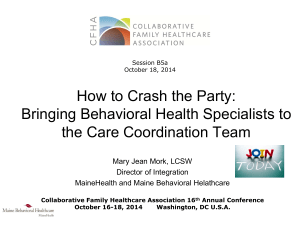Culture-Medicine-Behavioral Health - Session 3
advertisement
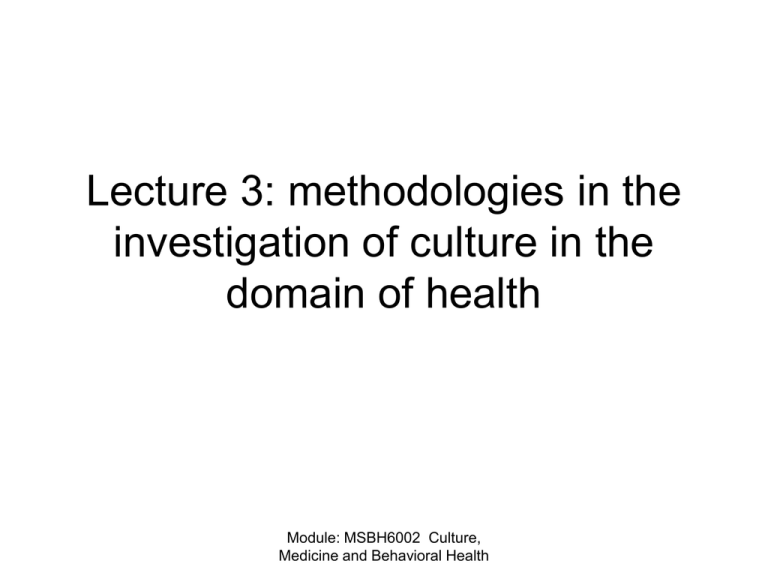
Lecture 3: methodologies in the investigation of culture in the domain of health Module: MSBH6002 Culture, Medicine and Behavioral Health PART I: Basic theories on culture perspectives in medicine Module: MSBH6002 Culture, Medicine and Behavioral Health What is “culture”? - Culture is the context of our live experience (cf.Geertz, 1971). – Then, “culture” is both something which is “out-there” (texts, classics, etc.) – Or it can be something implicit: (e.g. our mind, discourse over a particular thing) (cf. Lévy Bruhl, 1928; Levi-Strauss, 1963) – Culture is a system of differentiation. Module: MSBH6002 Culture, Medicine and Behavioral Health What is culture? (II) • Culture can be static as well as dynamic, depends on the nature of a specific culture (closed system? Open system?) • Culture can be analyzed in a macroscopic level (e.g. the socio-political systems, history, language, religion) • Culture can also be analyzed in a microscopic level (e.g. dressing code, daily life practices, stories and myths, folk art). • Culture can be bound to a particular race (e.g. Chineseculture), a particular group (e.g. Hakka culture) or a particular place (e.g. New Territory Culture). It depends on the scope of the study. Module: MSBH6002 Culture, Medicine and Behavioral Health Why culture matters in the study of behavioral health? • Thomas Szasz (1957; 1997): In psychiatry, or in the field of mental health in general, confused the following basic concepts: diagnosis and disease, lesion and (mis)behavior, illness and patient role; illness and incompetence, and lawfulness and lawlessness of subject’s behavior. • The boundary of these important concepts are different in different cultures. (see case of homosexuality). • Psychiatry can be more regarded as a branch of law rather than medicine (Szasz, 1997). • Similar arguments has been independently by PostStructuralist thinkers like Foucault (1961) Module: MSBH6002 Culture, Medicine and Behavioral Health Why culture matters in the study of behavioral health? (II) • Thomas Kuhn: (1968/1970) The structure of scientific revolution. • There are always times where incommersurable paradigms (a system of terminology, epistemological assumptions, methodology, and criteria for good research) complete with each other. • Debate: Is 辯証論治 in Chinese medicine commensurable with the idea of EvidenceBased medicine? Module: MSBH6002 Culture, Medicine and Behavioral Health Culture and medicine: two different approaches • Emic approach: – Documentary of a particular culture’s medical system: ethnomedicine – Interpretation of practices and the underlying belief system, based on the indigenous views • Etic approach – Based on the available to provide an explanation that is different from emic approach. – Try to provide a meta- perspective on the phenomenon through different frameworks. Module: MSBH6002 Culture, Medicine and Behavioral Health Culture and health: relevant disciplines • Medical anthropology – method: ethnography • Medical sociology – Method: surveys, analysis of longitudinal data, narrative analysis, grounded theory, epidemiology • History – Method: historiography • Cultural analysis – Method: discourse analysis, critical theory Module: MSBH6002 Culture, Medicine and Behavioral Health 1. Medical Anthropology • The task of medical anthropology (from Nichter, 1992) – 1. Descriptive studies of folk, non-biomedical, or biomedical forms of healing. – 2. Historical studies of disease and medical treatment – 3. Re-discover the losing traditions of medical systems – 4. Studies of changing perceptions on health – 5. Studies of health-seeking behavior and its patterns – 6. Tracing the changing taxonomy in illness – 7. Finding out the linkage between social norms and illness beliefs. Module: MSBH6002 Culture, Medicine and Behavioral Health 1. Medical Anthropology (2) – 8. Trace the history of institutions in medicine in a particular culture – 9. Studies of the efficacy of medicines, healing techniques, and procedures which are contextualized and attend to their content as well as performance, expectations, as well as criteria of assessment. It’s not necessary to archive ALL of the above goals within one study. Module: MSBH6002 Culture, Medicine and Behavioral Health 1. Medical Anthropology: examples • Medical Anthropology can be very simple: you can simple make a documentation over a particularly medical system that is not known in the outside communities. • Case study: Margaret Tarwick (1992) An Ayurvedic Theory of Cancer • Exercise: describe how medical anthropology is applied in this article. Module: MSBH6002 Culture, Medicine and Behavioral Health 2. Medical Sociology • Although sociology is overlapping with anthropology, medical sociology is more interested on the impact of social norms and social institutions on individual’s health related phenomena (e.g. medical choice, attitude to health, etc). • Medical sociology is partially overlapping with community medicine, yet it embrace more critical and more nonstatistical approaches on the same problem. • Survey and questionnaires are frequently used method in medical sociology. • Case study: Stella R. Quah (2001) on illness behavior in Singapore. • Questions: If the same issue is adopted with a medical anthropological perspective, what would it be like? Module: MSBH6002 Culture, Medicine and Behavioral Health Histroiography • Closely related to ethnography method adopted by medical anthropology. • However, unlike ethnography, which focus more on myths and people’s perception, historiography focus more on historical facts and its impact on the changing perception over a particular health-related issue. • Example: McMahon, K. (2002). The fall of the god of money : opium smoking in nineteenth-century China → A good source of insight for anti-drug compaigns Module: MSBH6002 Culture, Medicine and Behavioral Health Historiography: case studies • Five mineral powder (五石散) usage in Jin Dynasty (265 – 420 A.D.) • 五石散﹕石鐘乳、石硫磺、白石英、紫石 英、赤石脂 • Compare Five mineral powder with Ecstasy use in Hong Kong Module: MSBH6002 Culture, Medicine and Behavioral Health Cultural Analysis • Cultural analysis – It’s related to medical sociology and literal analysis, it’s less “scientific” but more focus on creativity and precise observation to social phenomena. – Analysis method: Discourse analysis (e.g. criticize fad of weight-reduction through cultural discourse) • Discourse analysis can be regarded as an alternative form of historiography (e.g. Foucault, 1961), but it’s surely value-laiden (while history emphasize on neutrality). • Discourse analysis as a tool for bio-politics (Foucault, 1978, 1982, 1984). Module: MSBH6002 Culture, Medicine and Behavioral Health Case studies • Fad of weight-reduction programs. – Explanations? – Ideal body shape as exploitation in capitalist society? – Anorexia bulimia as a socially-constructed illness? (what about foot-binding in China 紥 腳)? Module: MSBH6002 Culture, Medicine and Behavioral Health Implication on new “diseases” which is related to mental health • Intellect addiction • Personality disorders • …… • Reflections: how to conclude a “new” disease, and how to conclude that it’s merely a cultural phenomenon? Module: MSBH6002 Culture, Medicine and Behavioral Health Part II: Case study: Taoism and its relationship with health practice Module: MSBH6002 Culture, Medicine and Behavioral Health 本土健康體系﹕道教的分析 問題﹕道教對中國人的健康行為有何啓示, 又有何影響? 分析的角度﹕內在邏輯及其變體 技術及其目的 衍生的健康觀念 道教現代化問題 Module: MSBH6002 Culture, Medicine and Behavioral Health • 參考資料﹕ • 陳耀庭、李子微、劉仲宇﹝編﹞﹕道家養 生術。上海﹕復旦大學出版,1993。 Module: MSBH6002 Culture, Medicine and Behavioral Health 基本理念及其變型 • 戰國﹕ 主流 – 參透生死,檢視重估一切分類及標準,主張回歸自然。 – 老子﹕復歸於嬰兒 – 莊子: 至人無己> 神人無功> 聖人無名 (s1) 逆流﹕楊朱﹕復歸自然=盡情享樂 (s1 > s2) 此兩者構成道家的正面與反面 • 漢代以後﹕混合了陰陽家的學說和本土宗教 – – – – 開始追求長生不老及成仙 (與戰國時期不同) (s3, s4) 與醫藥學開始混合,並與陰陽家同時混合成為中醫的主導思想。 開始由 非-宗教 演變成一種宗教系統 (s4) 開始加入武術修練 (唐代) Module: MSBH6002 Culture, Medicine and Behavioral Health 技術及其目的 • 養生為各種道家技術的主題→ 以「盡天年」 為主 • 衍生﹕盡天年= 福澤後代 → 保健有其道德 責任 (道德化,s6 > anti s1) 盡天年 → 升仙 (s4) 升仙 → 目的。 養生→ 由目的變為手段 • 「道德」在道家技術中成為各派分歧之點 ﹝房中術、男女相修、老莊派 vs. 楊朱學派) Module: MSBH6002 Culture, Medicine and Behavioral Health 技術及其目的 (ii) • 養生技法 • 內在形﹕導引術 (運動)、胎息、守一/ 存思 法﹝冥想﹞、內丹功﹝氣功+冥想﹞ • 外在形﹕吐納服氣﹝呼吸法﹞、外丹、草 藥 • 內外互動形﹕房中術 ( 性學) Module: MSBH6002 Culture, Medicine and Behavioral Health 道教的兩面 • 道教兩種可能性﹕ – 1. 以養生為目標,放下生死的憂慮,投入自然 之轉化,不為情緒所役,以盡享天年 – 2. 以成仙為目標, 保持一種形而上的永生觀, 以養生為一種宗教使命 Module: MSBH6002 Culture, Medicine and Behavioral Health 道教衍生的健康概念 • 在真人實驗中大量豐富了中藥的藥理學 • 使陰陽五行以及平衡的觀點成為中國文化 的主流 • 節制與及方法成為主流的健康概念﹝性及 飲食的節制→ 辟谷﹞ • 但這些概念是以模糊的敘述﹝discourse﹞ 以各施各法的演繹以文字、宜忌及飲食方 法而流存。 Module: MSBH6002 Culture, Medicine and Behavioral Health 道教的現代化 • 問題 – 道教理念雖然仍繼續影響華人的健康觀,但他 和現代社會的理念有多少契合性? – 道教理念如何可以去宗教化,成為純綷的健康 論述? – 宗教化的過程如何令健康教育變得更有效率? Module: MSBH6002 Culture, Medicine and Behavioral Health

